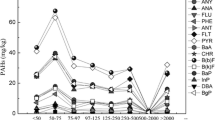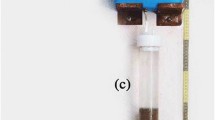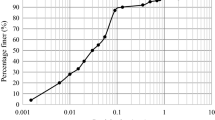Abstract
A study on five nonionic surfactants (Arkopal-N-060, Arkopal-N-080, Arkopal-N-100, Hosaf-541-KS and Tween-80)commercially available in South Africa was carried out todetermine their effect on the desorption and degradation ofcreosote in a soil contaminated with 250 000 mg kg-1creosote with a view to developing a cost effective methodologyfor treating creosote contaminated soils. The surfactants werestudied in concentrations of 0.01, 0.1, 0.35, 0.5 and 1.0% (v/v) in liquid cultures. Results from the studies showedthat all the surfactants studied were able to enhance thedesorption and degradation of creosote to different extents. Theenhancement ranged from as little as <10% in 0.1% surfactant toas high as 45% in 0.5% surfactant. The effect on degradation ofcreosote was more obvious (30–65%) in the different surfactantsat different concentrations. Arkopal-N-060 was observed to be themost effective in the desorption and degradation of creosote. Theeffect of Hosaf-541-KS on the degradation of creosote was foundto be comparable with those of Arkopal-N-060, however, itsdesorption capabilities were much lower than those of Arkopa-N-060.The concentration of the surfactant was found to play asignificant role in desorption of creosote. It was observed thatsurfactant concentrations of 0.35 and 0.5% were the mosteffective in the desorption of creosote. Above and below theseconcentrations, the effect of the surfactants was observed todecrease. All surfactants studied were not found to inhibitmicrobial growth at the concentrations studied.
Similar content being viewed by others
References
Abdul, A. S., Gibson, T. L., Ang, C. C., Smith, J. C. and Sobcznski, R. E.: 1992, ‘In situ washing of polychlorinated biphenyls and oils from a contaminated site’, Ground Water 30, 219–231.
Alexander, M.: 1999, Biodegradation and Bioremediation, Academic Press, San Diego, 302 pp.
Atlas, R. M.: 1981, ‘Microbial degradation of petroleum hydrocarbons: An environmental perspective’, Microbial Rev. 45, 180–209.
Baker, K. H. and Herson, D. S.: 1994, Bioremediation, McGraw-Hill, Toronto, 375 pp.
Becher, P.: 1965, Emulsions: Theory and Practice, Reinhold, New York, 57 pp.
Carriere, P. P. E. and Mesania, F. A.: 1995, ‘Enhanced biodegradation of creosote-contaminated soil’, Waste Management 15(8), 579–583.
Cooney, J.: 1984. ‘The Fate of Petroleum Pollutants in Fresh-water Ecosystems’, in R. M. Atlas (ed.), Petroleum Microbiology, MacMillan, New York, pp. 399–433.
Ellis, B.: 1994, ‘Reclaiming Contaminated Land: In situ/ex situ Remediation of Creosote-and Petroleum Hydrocarbon-contaminated Sites’, in P. E. Flatham, D. E. Jerger and J. H. Exner (eds), Bioremediation: Field Experience, Lewis Publishers, London, pp. 107–128.
Gjessing, E. T. and Berglind, L.: 1981, ‘Adsorption of PAH to aquatic humus’, Arch. Hydrobiol. 92, 24–30.
Guerin, W. F. and Boyd, S. A.: 1992. ‘Differential bioavailability of soil-sorbed naphthalene to two bacterial species’, Appl. Environ. Microbiol. 58, 1142–1152.
Gutnik, D. L. and Rosenberg, E.: 1977, ‘Oil tankers and pollution: A microbiological approach’, Annu. Rev. Microbiol. 31, 379.
Hansch, C. and Fujita, T.: 1964, ‘A method for the correlation of biological activity and chemical structure’,J. Am. Chem. Soc. 36, 1616–1626.
Hughes, J. B., Beckles, D. M., Chandra, S. D. and Ward, C. H.: 1997, ‘Utilization of bioremediation processes for the treatment of PAH-contaminated sediments’,J. Indust. Microbiol. Biotechnol. 18, 152–160.
Karickhoff, S. W.: 1980, ‘Sorption Kinetics of Hydrophobic Pollutants in Natural Sediments’, in R. A. Baker (ed.), Contaminants and Sediments. Vol. 2. Fate and Transport Studies, Modeling, Toxicity, Ann Arbor Science, Ann Arbor, pp. 193–205.
Kimball, S. L.: 1994, ‘The Use of Surfactants to Enhance Pump-and-treat Process for in situ Soil Remediation’, in D. L. Wise and D. J. Trantolo (eds), Remediation of Hazardous Waste Contaminated Soils, Marcel Dekker Inc., New York.
Lee, M. D., Thomas, J. M., Borden, R. C., Bedient, P. B., Ward, C. H. and Wilson, J. T.: 1988, ‘Biorestoration of aquifers contaminated with organic compounds’, CRC Crit. Rev. Environ. Control. 18, 29–89.
Lees, Z. M.: 1996, ‘Bioremediation of Oil-contaminated Soil: A South African Case Study’, Ph.D. Thesis, Department of Micrbiology and Plant Pathology, University of Natal, Pietermaritzburg, South Africa, 350 pp.
Liu, Z., Laha, S. and Luthy, R. G.: 1991, ‘Surfactant solubilization of polycyclic aromatic hydrocarbon compounds in soil water suspensions’, Water Sci. Technol. 23, 475–485.
McDermott, J. B., Unterman, R., Brennan, M. J., Brooks, R. E. Mobley, D. P., Scwartz, C. C. and Dietrich, D. K.: 1989, ‘Two strategies for PCB soil remediation: Biodegradation and surfactant extraction’, Environ. Progress 8, 46–51.
Mihelcic, J. R and Luthy, R. C.: 1991, ‘Sorption and microbial degradation of naphthalene in soilwater suspensions under denitrification conditions’, Environ. Sci. Technol. 25, 169–177.
Miller, M. E. and Alexander, M.: 1991, ‘Kinetics of bacterial degradation of benzylamine in a montmorillonite suspension’, Environ. Sci. Tech. 25, 240–245.
Miller, R. M.: 1995, ‘Surfactant-enhanced Bioavailability of Slightly Soluble Organic Compounds’, in H. D. Skipper and R. F. Turco (eds), Bioremediation Science and Application. Soil Science, Special Publication, No. 43, Soil Science Society of America.
Mulkins-Phillip, G. J. and Stewart, J. E.: 1974, ‘Effect of 4 dispersants on biodegradation and growth of bacteria on crude oil’, Appl. Microbiol. 28, 547–552.
Nakahara, T., Hisasuka, K. and Minoda, Y.: 1981, J. Ferment. Technol. 59, 415–418.
Oberbremer, A., Müller-Hertig, R. and Wagna, F.: 1990, ‘Effect of the addition of microbial surfactant on hydrocarbon degradation in a soil population in a stirred reactor’, Appl. Microbiol. Biotechnol. 32, 485–489.
Platt, J. J., Backhus, D. A., Capel, P. D. and Eisenreich, S. J.: 1996, ‘Temperature-dependent sorption of naphthalene, phenanthrene and pyrene to low organic carbon sediments’, Environ. Sci. Technol. 30, 751–760.
Sanseverino, J., Graves, D. A., Leavitt, M. E., Gupta, S. K. and Luthy, R. G.: 1994, ‘Surfactantenhanced Bioremediation of Polynuclear Aromatic Hydrocarbons in Coke Waste’, in D. L. Wise and D. J. Trantolo (eds), Remediation of Hazardous Waste Contaminated Soils, Marcel Dekker, Inc., New York.
Tan, K. H.: 1998, Principles of Soil Chemistry, 3rd ed., Marcel Dekker Inc., New York.
Yalkowski, S. H. and Valvani, S. C.: 1979, ‘Solubility and partitioning 2. Relationships between aqueous solubilities, partition coefficients and molecular surface areas of rigid aromatic hydrocarbons’, J. Chem. Engin. Data 24, 127–129.
Yeom, I. T., Ghosh, M. M. and Cox, C. D.: 1996, ‘Kinetic aspects of surfactant solubilization of soil-bound polycyclic aromatic hydrocarbons’, Environ. Sci. Technol. 30, 1589–1595.
Author information
Authors and Affiliations
Corresponding author
Rights and permissions
About this article
Cite this article
Atagana, H.I., Haynes, R.J. & Wallis, F.M. The Use of Surfactants as Possible Enhancers in Bioremediation of Creosote Contaminated Soil. Water, Air, & Soil Pollution 142, 137–149 (2003). https://doi.org/10.1023/A:1022070504841
Issue Date:
DOI: https://doi.org/10.1023/A:1022070504841




